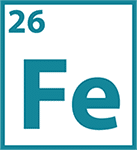Symbol: Fe
Availability: available to plants as Fe2+, Fe3+. Fe2+ is taken up preferentially compared with Fe3+.
Iron functions

It is required for the formation of chlorophyll in plant cells.


It is required in nitrate and sulfate assimilation processes.

It serves as an activator for biochemical processes such as respiration, photosynthesis.

It is necessary for plant hormone synthesis such as ethylene or abscisic acid.
Iron (Fe) is one of the micronutrients which is responsible for the quality and quantity of crop yields and, therefore, its deficiency significantly impacts agricultural production at the global level. The iron concentration in plant leaf tissues varies between plant species, but it is generally between 50 and 250 ppm dried and ground. If the iron concentration is less than 50 ppm, there are usually signs of deficiency.
Iron is the third most limiting nutrient for plant growth and metabolism. The Fe content of soils is high, being the fourth element in Earth’s crust in percentage. Therefore, the widespread limited availability of Fe for plant nutrition is not related to its low absolute soil content, but rather to its extremely low solubility. Fe deficiency is a typical feature of alkaline soils (pH 8), where Fe is readily oxidized and is predominately in the form of insoluble ferric oxides. Under aerated conditions and pH values above 7, the total concentration of inorganic Fe species in the soil solution is lower than that required for an optimal growth of plants. At lower pH, the ferric Fe is freed from the oxide, and becomes more available for uptake by roots. Considering that alkaline soils represent about 25% of Earth’s surface, from an agronomical point of view, the consistency of this problem is evident. Therefore, it is clear why the management of plant Fe nutrition has been the focus of great attention in recent decades.
Iron uptake by the plant is not as simple as with other essential elements. Uptake of Fe by the plant is an active process, that is, energy is expended by the plant to take in Fe. Iron uptake is dependent on the plant’s ability to reduce Fe3+ to Fe2+ and remove it from the complex or chelating compound. Iron uptake can be interfered with by other cations in the soil solution such as manganese (Mn) and calcium (Ca).
Iron in the plant is mostly in the ferric form, and much of the Fe is found in the plastids. Another significant pool of Fe is found in the apoplast (extracellular area) of the older part of the root. Iron is relatively immobile once incorporated in compounds in the upper parts of the plants. Re-translocation of Fe from one shoot tissue or plant part to another is negligible.
Iron is a critical element for the whole metabolism of plants. It is required for the formation of chlorophyll in plant cells and it is essential for the maintenance of chloroplast structure and function. It serves as an activator for biochemical processes such as respiration, photosynthesis. Fe is also part of protein ferredoxin and is required in nitrate and sulfate assimilation processes. It is also an active cofactor of many enzymes that are necessary for plant hormone synthesis such as ethylene or abscisic acid.
Iron deficiency is a common nutritional disorder in many crop plants, resulting in poor yields and reduced nutritional quality. Iron is relatively immobile once incorporated in compounds in the upper parts of the plants. Re-translocation of Fe from one shoot tissue or plant part to another is negligible. Therefore, Fe deficiency symptoms show up first in the youngest leaves. These young leaves show yellowing, sometimes referred to as “iron chlorosis.” Often there is an interveinal appearance where the veins remain green for a time as the deficiency progresses. Soils with a basic reaction (>pH 7.2) often result in Fe deficiency because under these elevated pH conditions Fe is largely in the oxide and unavailable form. Acidic soils also can lead to Fe deficiency, likely due to manganese competition with Fe uptake. High Ca and carbonate concentrations in soil from over-liming also can lead to Fe deficiencies (“lime-induced Fe chlorosis”) due to the high pH (more insoluble Fe) and competition of Ca with Fe uptake by the root. For the same reason, continual use of irrigation water with high concentrations of carbonates can lead to chlorosis.
Fe deficiency is sometimes confused with nitrogen deficiency, but Iron deficiency symptoms manifest themselves in the younger leaves while Nitrogen deficiency is manifest first in the older leaves because N can be mobilized from the older leaves to satisfy the needs in the upper plant.
Fe deficiency is a typical feature of alkaline soils with high pH where iron form insoluble ferric oxides and is unavailable for plants. Besides, also in the soil-less growing method all the nutrients essential to the plant, including Iron, have to be applied via the drip irrigation system. Iron can be applied as fertilizer in several forms and by several methods. Consideration must be given to the soil chemical reactions that affect Fe solubility and plant availability. Fe can be applied as ferrous sulfate or in a chelated form. Ferrous sulfate (FeSO4) applied to soil, it is often ineffective because its Fe quickly transforms to Fe3+ and precipitates as one of the Fe oxides before the plant can absorb the Fe, especially in soils with high pH and bicarbonate levels. Iron chelates are compounds that stabilize metal ions (in this case Fe) and protect them from oxidation and precipitation. Today, synthetic chelates are the most used products to prevent and cure iron deficiency in plants. Despite the good chelation properties of synthetic components, like EDDHA, these compounds are characterized by a low degree of biodegradation that brings many side effects with risks for the environment and human health. The accumulation of synthetic chelates in agricultural ecosystems can also hinder the achievement of sustainability objectives.
In this regard, it is necessary to privilege strategies that also meet the great current challenges of agriculture to protect the environment and human health choosing solutions of natural origin, completely biodegradable, harmless to living organisms and respectful of biodiversity, which leaves no residues in the environment or in the crops. Fe biochelation based on vegetal peptides has numerous advantages and differences compared to the technologies already available. First, compared to traditional synthetic chelation, it is a 100% natural technology, environmentally friendly, harmless to living organisms and respectful of biodiversity, which leaves no residues in the soil or in the crops. In addition, thanks to the presence of plant peptides there is a dual action nutrient biochelation and biostimulat that improves the absorption of the element itself, also boosting plant metabolism. Instead, synthetic chelating agents cannot be used by plants, they are only a carrier of the micronutrients. Iron is biochelated in the bivalent ionic form which is the form readily used by plants and easier to absorb; while synthetic chelate agents, like EDDHA, chelate iron in the trivalent form which is not readily assimilable by plants.
Iron is the third most limiting nutrient for plant growth and metabolism. It is one of the micronutrients which is responsible for the quality and quantity of crop yields.







